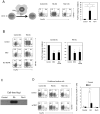Retinoic acid promotes the development of Arg1-expressing dendritic cells for the regulation of T-cell differentiation
- PMID: 23322377
- PMCID: PMC3826817
- DOI: 10.1002/eji.201242772
Retinoic acid promotes the development of Arg1-expressing dendritic cells for the regulation of T-cell differentiation
Abstract
Arginase I (Arg1), an enzyme expressed by many cell types including myeloid cells, can regulate immune responses. Expression of Arg1 in myeloid cells is regulated by a number of cytokines and tissue factors that influence cell development and activation. Retinoic acid, produced from vitamin A, regulates the homing and differentiation of lymphocytes and plays important roles in the regulation of immunity and immune tolerance. We report here that optimal expression of Arg1 in DCs requires retinoic acid. Induction of Arg1 by retinoic acid is directly mediated by retinoic acid-responsive elements in the 5' noncoding region of the Arg1 gene. Arg1, produced by DCs in response to retinoic acid, promotes the generation of FoxP3(+) regulatory T (Treg) cells. Importantly, blocking the retinoic acid receptor makes DCs hypo-responsive to known inducers of Arg1 such as IL-4 and GM-CSF in Arg1 expression. We found that intestinal CD103(+) DCs that are known to produce retinoic acid highly express Arg1. Our results establish retinoic acid as a key signal in expression of Arg1 in DCs.
© 2013 WILEY-VCH Verlag GmbH & Co. KGaA, Weinheim.
Figures







Similar articles
-
Retinoic acid primes human dendritic cells to induce gut-homing, IL-10-producing regulatory T cells.Mucosal Immunol. 2015 Mar;8(2):265-78. doi: 10.1038/mi.2014.64. Epub 2014 Jul 16. Mucosal Immunol. 2015. PMID: 25027601
-
GM-CSF and IL-4 synergistically trigger dendritic cells to acquire retinoic acid-producing capacity.Int Immunol. 2009 Apr;21(4):361-77. doi: 10.1093/intimm/dxp003. Epub 2009 Feb 3. Int Immunol. 2009. PMID: 19190084 Free PMC article.
-
Retinoic acid prevents mesenteric lymph node dendritic cells from inducing IL-13-producing inflammatory Th2 cells.Mucosal Immunol. 2014 Jul;7(4):786-801. doi: 10.1038/mi.2013.96. Epub 2013 Nov 13. Mucosal Immunol. 2014. PMID: 24220301
-
Retinoic acid-dependent regulation of immune responses by dendritic cells and macrophages.Semin Immunol. 2009 Feb;21(1):22-7. doi: 10.1016/j.smim.2008.07.007. Epub 2008 Sep 7. Semin Immunol. 2009. PMID: 18778953 Free PMC article. Review.
-
Intestinal CD103+ dendritic cells: master regulators of tolerance?Trends Immunol. 2011 Sep;32(9):412-9. doi: 10.1016/j.it.2011.06.003. Epub 2011 Aug 2. Trends Immunol. 2011. PMID: 21816673 Review.
Cited by
-
Myeloid Cell-Derived Arginase in Cancer Immune Response.Front Immunol. 2020 May 15;11:938. doi: 10.3389/fimmu.2020.00938. eCollection 2020. Front Immunol. 2020. PMID: 32499785 Free PMC article. Review.
-
All-trans retinoic acid induces arginase-1 and inducible nitric oxide synthase-producing dendritic cells with T cell inhibitory function.J Immunol. 2014 Jun 1;192(11):5098-108. doi: 10.4049/jimmunol.1303073. Epub 2014 Apr 30. J Immunol. 2014. PMID: 24790153 Free PMC article.
-
Host and microbial factors in regulation of T cells in the intestine.Front Immunol. 2013 Jun 10;4:141. doi: 10.3389/fimmu.2013.00141. eCollection 2013. Front Immunol. 2013. PMID: 23772228 Free PMC article.
-
Regulatory dendritic cells for immunotherapy in immunologic diseases.Front Immunol. 2014 Jan 31;5:7. doi: 10.3389/fimmu.2014.00007. eCollection 2014. Front Immunol. 2014. PMID: 24550907 Free PMC article. Review.
-
Amino acid metabolism and signalling pathways: potential targets in the control of infection and immunity.Eur J Clin Nutr. 2021 Sep;75(9):1319-1327. doi: 10.1038/s41430-021-00943-0. Epub 2021 Jun 23. Eur J Clin Nutr. 2021. PMID: 34163018 Free PMC article. Review.
References
-
- Grohmann U, Bronte V. Control of immune response by amino acid metabolism. Immunol Rev. 2010;236:243–264. - PubMed
-
- Peranzoni E, Marigo I, Dolcetti L, Ugel S, Sonda N, Taschin E, Mantelli B, et al. Role of arginine metabolism in immunity and immunopathology. Immunobiology. 2007;212:795–812. - PubMed
-
- Popovic PJ, Zeh HJ, 3rd, Ochoa JB. Arginine and immunity. J Nutr. 2007;137:1681S–1686S. - PubMed
Publication types
MeSH terms
Substances
Grants and funding
LinkOut - more resources
Full Text Sources
Other Literature Sources
Molecular Biology Databases
Research Materials
Miscellaneous

